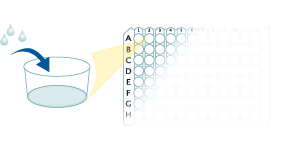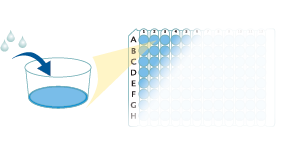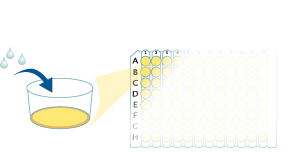 全部商品分类
全部商品分类



 下载产品说明书
下载产品说明书 下载SDS
下载SDS 用小程序,查商品更便捷
用小程序,查商品更便捷


 收藏
收藏
 对比
对比 咨询
咨询Sample Values
Serum/Plasma - Samples from apparently healthy volunteers were evaluated for the presence of human PCSK9 in this assay. No medical histories were available for the donors used in this study.| Sample Type | Mean (ng/mL) | Range (ng/mL) | Standard Deviation (ng/mL) |
| Serum (n=37) | 313 | 177-460 | 71.5 |
| EDTA plasma (n=37) | 308 | 160-521 | 73.3 |
| Heparin plasma (n=37) | 315 | 159-547 | 81.7 |
Cell Culture Supernates - HepG2 human hepatocellular carcinoma cells were cultured in DMEM supplemented with 10% fetal bovine serum, 2 mM L-glutamine, 100 U/mL penicillin, and 100 μg/mL streptomycin sulfate. An aliquot of the cell culture supernate was removed, assayed for human PCSK9, and measured 47.2 ng/mL.
Recovery
The recovery of PCSK9 spiked to levels throughout the range of the assay was evaluated.
| Sample Type | Average % Recovery | Range % |
|---|---|---|
| Cell Culture Media (n=4) | 107 | 100-111 |
Linearity
Scientific Data
Assay Procedure
Refer to the product- Prepare all reagents, standard dilutions, and samples as directed in the product insert.
- Remove excess microplate strips from the plate frame, return them to the foil pouch containing the desiccant pack, and reseal.
- Add 100 µL of Assay Diluent to each well.
- Add 50 µL of Standard, control, or sample to each well. Cover with a plate sealer, and incubate at room temperature for 2 hours.
- Aspirate each well and wash, repeating the process 3 times for a total of 4 washes.
- Add 200 µL of Conjugate to each well. Cover with a new plate sealer, and incubate at room temperature for 2 hours.
- Aspirate and wash 4 times.
- Add 200 µL Substrate Solution to each well. Incubate at room temperature for 30 minutes. PROTECT FROM LIGHT.
- Add 50 µL of Stop Solution to each well. Read at 450 nm within 30 minutes. Set wavelength correction to 540 nm or 570 nm.





Human Proprotein Convertase 9/PCSK9 Quantikine ELISA Kit Summary

Background: Fibroblast Activation Protein alpha/FAP
Proprotein convertase subtilisin kexin 9 (PCSK9), also named neural apoptosis-regulated convertase 1 (NARC-1), is a member of the proteinase K subfamily of subtilisin-related serine endoproteases. The full-length protein has 692 amino acids, including a signal peptide, a pro- domain, and a catalytic domain. PCSK9 is highly expressed in the liver, intestine, and kidney. It is initially synthesized as a soluble 74 kDa precursor protein. In the endoplasmic reticulum, it undergoes autocatalytic intramolecular cleavage to generate a 14 kDa pro- domain and a 60 kDa catalytic domain. These two domains remain associated when PCSK9 is secreted outside the cells (1-3). The primary physiologic function of PCSK9 is to mediate the degradation of low density lipoprotein receptor (LDL R). Early observations indicated that gain-of-function missense mutations in the PCSK9 gene can cause an autosomal dominant form of hypercholesterolemia (4, 5). The expression of PCSK9 was observed to be up-regulated by the sterol regulatory element binding proteins (SREBPs), a family of transcription factors that are responsible for the upregulation of genes involved in cholesterol and fatty acid metabolism, such as the LDL R gene (6, 7). Further experimental evidence revealed that in mice, when the PCSK9 gene was knocked out, the number of LDL R in hepatocytes increased, whereas when PCSK9 was over-expressed, the amount of LDL R protein was reduced in the liver (8, 9). In humans, genetic analyses have shown that individuals who have nonsense or loss-of-function mutations in the PCSK9 gene have significantly lower plasma LDL cholesterol levels (10, 11). These investigations clearly indicated that PCSK9 plays a key role in reducing the hepatic LDL R levels. Recently, the underlying mechanism has been uncovered: under normal physiologic conditions, the LDL R is internalized on the cell surface and directed to the endosomes in order to be recycled back to the cell surface. PCSK9 binds to the EGF domain of the LDL R and prevents LDL R from being sorted to the endosomes. Instead, the PCSK9/LDL R complex is redistributed to the lysosomes for degradation (12-14). As such, PCSK9 regulates the amount of LDL R in the circulation and modulates cholesterol levels. Serum PCSK9 concentrations have been found to be directly associated with cholesterol levels (15, 16). Since individuals with loss-of-function PCSK9 mutations have strikingly reduced risk of coronary heart diseases, PCSK9 has become an attractive drug target in recent years (17, 18). One approach is to generate small molecules that are able to interfere with PCSK9 autoactivation and its interaction with LDL R. Other approaches aiming to reduce the amounts of PCSK9 in the circulation, such as small interfering RNAs (siRNAs), have also shown promise (19, 20).







